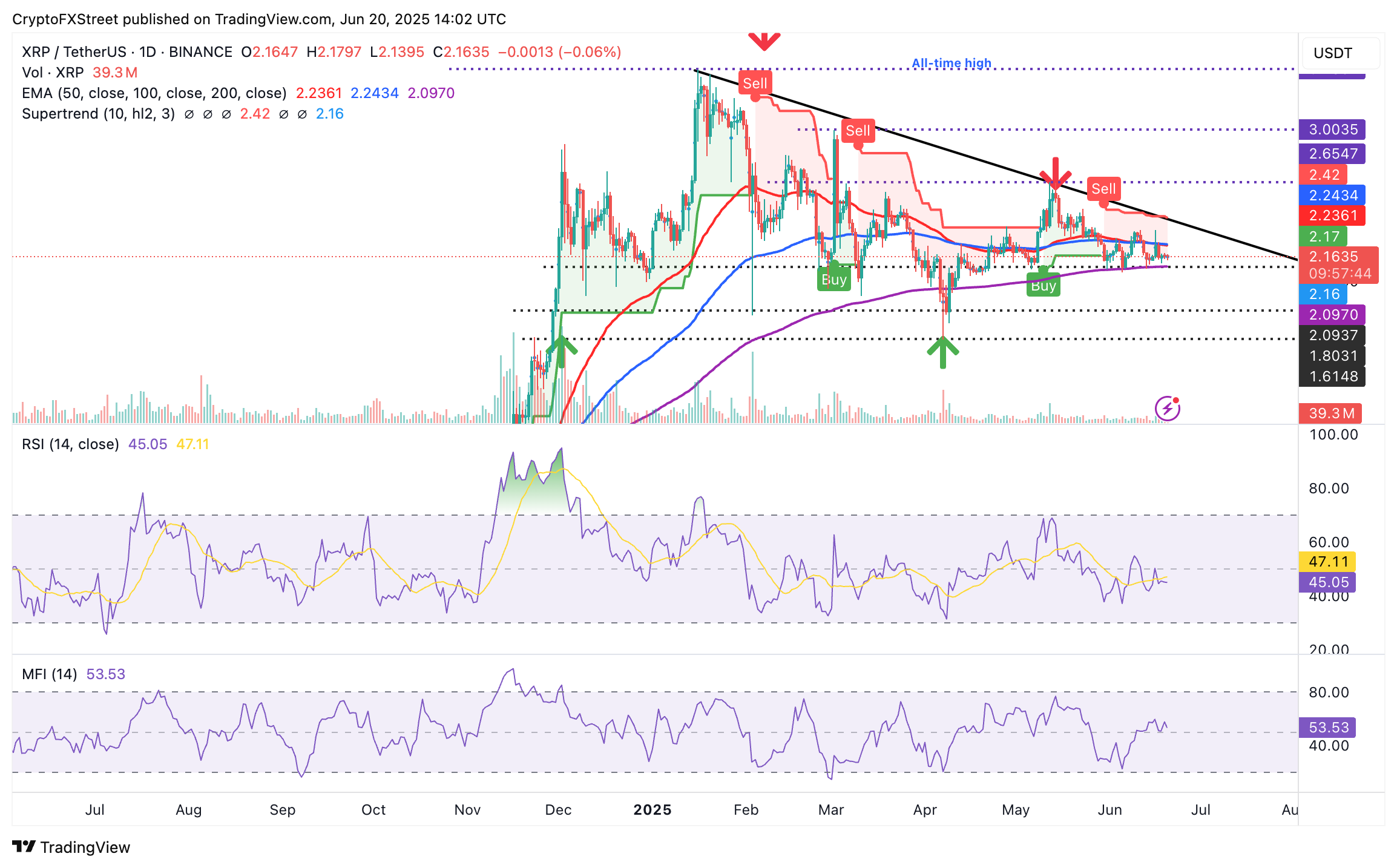Ripple Price Forecast: XRP extends consolidation as CTO Schwartz backs stablecoin-driven growth
- XRP continues to trade sideways, with support at $2.09 and resistance at $2.24.
- Ripple’s CTO, David Schwartz, emphasizes that stablecoins do not limit XRP but rely on its infrastructure for liquidity.
- A sell signal from the SuperTrend Indicator and unsteady money inflow into XRP could thwart the potential technical breakout.
Ripple (XRP) struggles to stage a recovery and sustains consolidation around $2.17 at the time of writing on Friday. Sentiment generally improved in the broader cryptocurrency market after United States (US) President Donald Trump said that he had delayed the decision regarding direct attacks on Iran for up to two weeks.
Bitcoin (BTC) ticked higher, stepping above $106,000, while Ethereum steadied gains above $2,550, reflecting relief for major digital assets. However, further price increases remain largely constrained, with XRP likely to extend consolidation into the weekend.
Stablecoins need XRP infrastructure for liquidity - Ripple CTO David Schwartz
Ripple’s Chief Technology Officer (CTO) David Schwartz said during a panel discussion shared by Xaif on X that stablecoins will not limit XRP. Instead, Schwartz emphasized that stablecoins such as Ripple’s RLUSD, Tether’s USDT and Circle’s USDC would rely heavily on the XRP infrastructure for liquidity.

According to Schwartz, XRP plays a fundamental role in stablecoin adoption, particularly as a liquidity bridge.
“If you imagine dozens of stablecoins and hundreds and hundreds of markets, there are probably not going to be as efficient as going through some sort of assets that aggregate like the US Dollar (USD) does today for smaller currencies. We see XRP playing that role,” Schwartz explained.
The move toward a stablecoin and tokenized assets-backed economy is gaining momentum rapidly in the US, particularly with the passage of the Guidance and Establishing Innovation for US Stablecoins (GENIUS) bill in the Senate earlier this week.
The advancement of the GENIUS bill to the House has been lauded as a monumental step toward progressive cryptocurrency regulations in the US.
Supporters of the bill argue that, in addition to overseeing the operations of stablecoin issuers, the GENIUS Act will ensure the seamless enforcement of anti-money laundering (AML) guidelines, transaction monitoring and customer due diligence in the same manner as traditional financial institutions.
Technical outlook: XRP extends consolidation
XRP’s technical outlook remains in limbo between support at $2.09, highlighted by the 200-day Exponential Moving Average (EMA), and a confluence resistance at around $2.24, established by the 100-day EMA and the 50-day EMA.
A break above the confluence hurdle at $2.24 could significantly boost XRP’s likelihood of lifting above the descending trendline, as shown on the daily chart below. Traders have their eyes set on key milestones, ranging from May’s peak of $2.65 to the supply area around $3.00, which was tested as resistance in early March.

XRP/USDT daily chart
On the contrary, the path of least resistance could flip downward if XRP slips under the 200-day EMA support at $2.09. Sellers already hold a significant claim on the trend, with the Relative Strength Index (RSI) dropping below the 50 midline.
This bearish outlook is underscored by the position of the Money Flow Index (MFI), which, although remaining above the midline, indicates a slight downward trend.
The MFI tracks the amount of money entering XRP, with a persistent decline likely to signal a shift from bulls to bears. In that case, price action below the 200-day EMA could accelerate losses past $2.00, bringing key levels tested in April at $1.80 and $1.61 into sight.
Ripple FAQs
Ripple is a payments company that specializes in cross-border remittance. The company does this by leveraging blockchain technology. RippleNet is a network used for payments transfer created by Ripple Labs Inc. and is open to financial institutions worldwide. The company also leverages the XRP token.
XRP is the native token of the decentralized blockchain XRPLedger. The token is used by Ripple Labs to facilitate transactions on the XRPLedger, helping financial institutions transfer value in a borderless manner. XRP therefore facilitates trustless and instant payments on the XRPLedger chain, helping financial firms save on the cost of transacting worldwide.
XRPLedger is based on a distributed ledger technology and the blockchain using XRP to power transactions. The ledger is different from other blockchains as it has a built-in inflammatory protocol that helps fight spam and distributed denial-of-service (DDOS) attacks. The XRPL is maintained by a peer-to-peer network known as the global XRP Ledger community.
XRP uses the interledger standard. This is a blockchain protocol that aids payments across different networks. For instance, XRP’s blockchain can connect the ledgers of two or more banks. This effectively removes intermediaries and the need for centralization in the system. XRP acts as the native token of the XRPLedger blockchain engineered by Jed McCaleb, Arthur Britto and David Schwartz.

